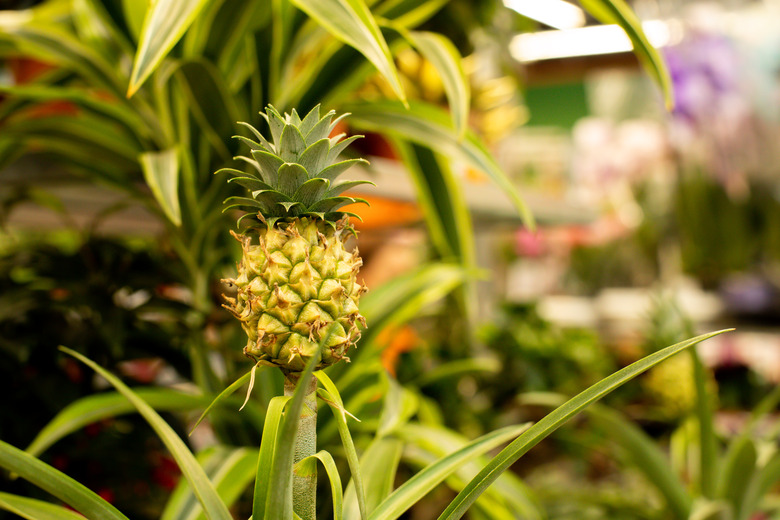Miniature Pineapple Plant Care
With small-scale fruit no larger than a tennis ball, the mini pineapple plant (Ananas spp., USDA zones 10-12) grows more as an ornamental oddity rather than a bountiful fruit crop. Although the ornamental fruits are edible, they're of poorer quality and do not taste as sweet as a market pineapple. Native to warm regions in tropical America and the Caribbean islands, the pineapple plant falters when temperatures drop below 60 degrees Fahrenheit. Maturing to about 18 inches tall and 24 inches wide, grow it in a container to bring it indoors to overwinter as a house plant.
One way to grow a miniature pineapple is by forcing an standard pineapple (Ananas comosus) into bloom when the plant is still immature. Because of the young age of the plant, it produces smaller, ornamental pineapples. The University of Florida IFAS Extension recommends the red pineapple (Ananas comosus var. bracteatus) as a vibrant departure from the standard pineapples. The ornamental fruits on this plant are vivid red.
A mini pineapple plant grows best and reaches optimal fruiting potential with:
- Full sun
- Loose, well-draining soil or potting mix
- Moist soil
- Water-soluble houseplant fertilizer
How Do You Take Care of a Dwarf Pineapple?
Full Sun is Best
The dwarf pineapple plant needs as much direct sunlight as possible, whether grown outdoors or as a house plant. At least six hours of sunlight daily helps warm the soil, as well as keep foliage firm and well-shaped. Too little light causes leggy or thin leaves, overly green coloration, and likely reduces the chances for production of a flower stalk and subsequent fruit.
Plant on Loose, Well-Draining Soil
While many bromeliads are epiphytes, growing as aerial plants that clasp to other plants, the miniature pineapple grows on soil. Grow it on well-draining fertile soil that is rich in humus. Sand-based soils with compost and mulch create good growing conditions if they stay evenly moist during the warmth of the growing season. Avoid heavy clay soils or those that remain soggy after rain or irrigation watering.
Keep Soil Moist
Water the miniature bromeliad freely during the growing season and when the flowering stalk is present. The soil should remain moist from spring to autumn. Pouring the water over the entire plant allows water to run into leaf gaps and crevices and drain away to the soil below. In winter, reduce watering so that the soil remains barely moist and dries out between watering.
Use Water-Soluble Fertilizer
When the pineapple plant is actively growing, apply a complete, water-soluble fertilizer monthly, according to label directions. The Texas A&M AgriLife Extension notes that a general houseplant fertilizer is suitable. If your plant is very young, pour or spray the fertilizer over the leaves so that it can collect in the leaf axils and slowly release nutrients. If your plant is established, apply the fertilizer directly to the soil or potting mix.
Flowers and Fruit
When the miniature pineapple reaches maturity, or when it's been forced to bloom early, the center of the rosette of spiny leaves produces a flower stalk. The stalk elongates and rises above the foliage to reveal a rounded cluster of lilac to red flowers with yellow bracts, resembling a pine cone. After the flowers fade, the ovaries swell into plump, pulpy masses to create a small pineapple fruit with a large crown of foliage.
The flower stalk may remain fully erect or eventually bends over to allow the mature fruit to drop to the soil below, where it will root and become a new plant. Consider staking the stalk to keep the plant looking more ornate and keep watering it during this time, so that the flower and fruits do not abort prematurely.
Miniature Ornamental Pineapple Plant Propagation
Once the plant fruits, it is destined to die. While the top of the small fruit grows into a new plant when it reaches the soil, the mother bromeliad also develops small new plants called pups at her base. The mother plant will slowly decline over one to three months, allowing the pups to increase in size.
Once the mother plant looks too tattered or brown, cut it off with a pruners at its base. Use gloves to protect yourself from the leaf spines. Take care when cutting so you do no remove or damage the one to three ornamental pineapple plant pups emerging from the mother plant's base.
With the mother plant removed, the pups gain more light, air and resources from the roots to grow more quickly. Within a year, these pup plants grow to a large size, often ready to flower and fruit, and continue the process if conditions are right.
